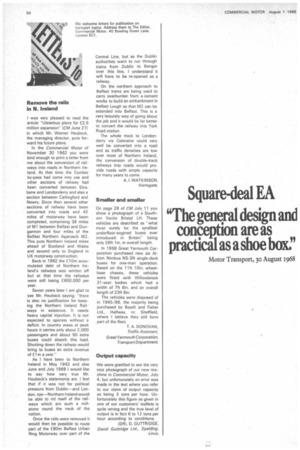Square-deal EA "The general design and conception are as practical as a shoe bee
Page 56

If you've noticed an error in this article please click here to report it so we can fix it.
Motor Transport, 30 August 1968
i was very pleased to read the article "Uisterbus plans for £2.5 million expansion" (CM June 27 in which Mr. Werner Heubeck, the managing director, puts forward his future plans.
In the Commercial Motor of November 30 1962 you were kind enough to print a letter from me about the conversion of railways into roads in Northern Ireland. At that time the Comber by-pass had come into use and other sections of railway had been converted between Strabane and Londonderry and also a section between Carlingford and Newry. Since then several other sections of railway have been converted into roads and 42 miles of motorway have been completed, comprising 38 miles of M1 between Belfast and Dungannon and four miles of the Belfast Northern Approach M2. This puts Northern Ireland miles ahead of Scotland and Wales and second only to England in UK motorway construction.
Back in 1962 the ElOm accumulated debt of Northern Ireland's railways was written off but at that time the railways were still losing £600,000 per year.
Seven years later I am glad to see Mr. Heubeck saying: "there is also no justification for keeping the Northern Ireland Railways in existence. It needs heavy capital infection. It is not expected to operate without a deficit. In country areas at peak hours it carries only about 2,000 passengers and about 50 extra buses could absorb this load. Shutting down the railway would bring to buses an extra revenue of Elm a year.
As I have been to Northern Ireland in May 1962 and also June and July 1968 I would like to say how very true Mr. Heubeck's statements are. I feel that if it was not for political pressure from Dublin—and London, too—Northern Ireland would be able to rid itself of the railways which are such a millstone round the neck of the nation.
Once the rails were removed it would then be possible to route part of the £80m Belfast Urban Ring Motorway over part of the Central Line, but as the Dublin authorities want to run through trains from Dublin to Bangor over this line, I understand it will have to be re-opened as a railway.
On the northern approach to Belfast trains are being used to carry overburden from a cement works to build an embankment in Belfast Lough so that M2 can be extended into Belfast. This is a very leisurely way of going about the job and it would be far better to convert the railway into York Road station.
The whole track to Londonderry via Coleraine could very well be converted into a road and as traffic densities are low over most of Northern Ireland, the conversion of double-track railways into roads would provide roads with ample capacity for many years to come.
A. I. WATKINSON, Harrogate
Smaller and smaller
On page 28 of CM July 11 you show a photograph of a Southern Vectis Bristol LH. These vehicles are described as "what must surely be the smallest underfloor-engined buses ever introduced in Britainbeing only 26ft lin. in overall length.
In 1959 Great Yarmouth Corporation purchased new six Albion Nimbus NS-3N single-deck buses for one-man operation. Based on the lift 10in. wheelbase chassis, these vehicles were fitted with Willowbrook 31-seat bodies which had a width of 7ft 6in. and an overall length of 23ft 6in.
The vehicles were disposed of in 1965/66, the majority being purchased by Booth and Fisher Ltd., Halfway, nr. Sheffield. where I believe they still form part of the fleet.
T. A. DONOVAN, Traffic Assistant, Great Yarmouth Corporation, Transport Department.
Output capacity
We were gratified to see the very nice photograph of our new machine in Commercial Motor, July 4, but unfortunately an error was made in the text where you refer to our claim of output capacity as being 3 tons per hour. Unfortunately this figure as given in one of our customers' leaflets is quite wrong and the true level of output is in fact 6 to 12 tons per hour according to conditions.
(DR). D. GUTTRIDGE, David Guttridge Ltd., Spalding, Lincs.


































































































